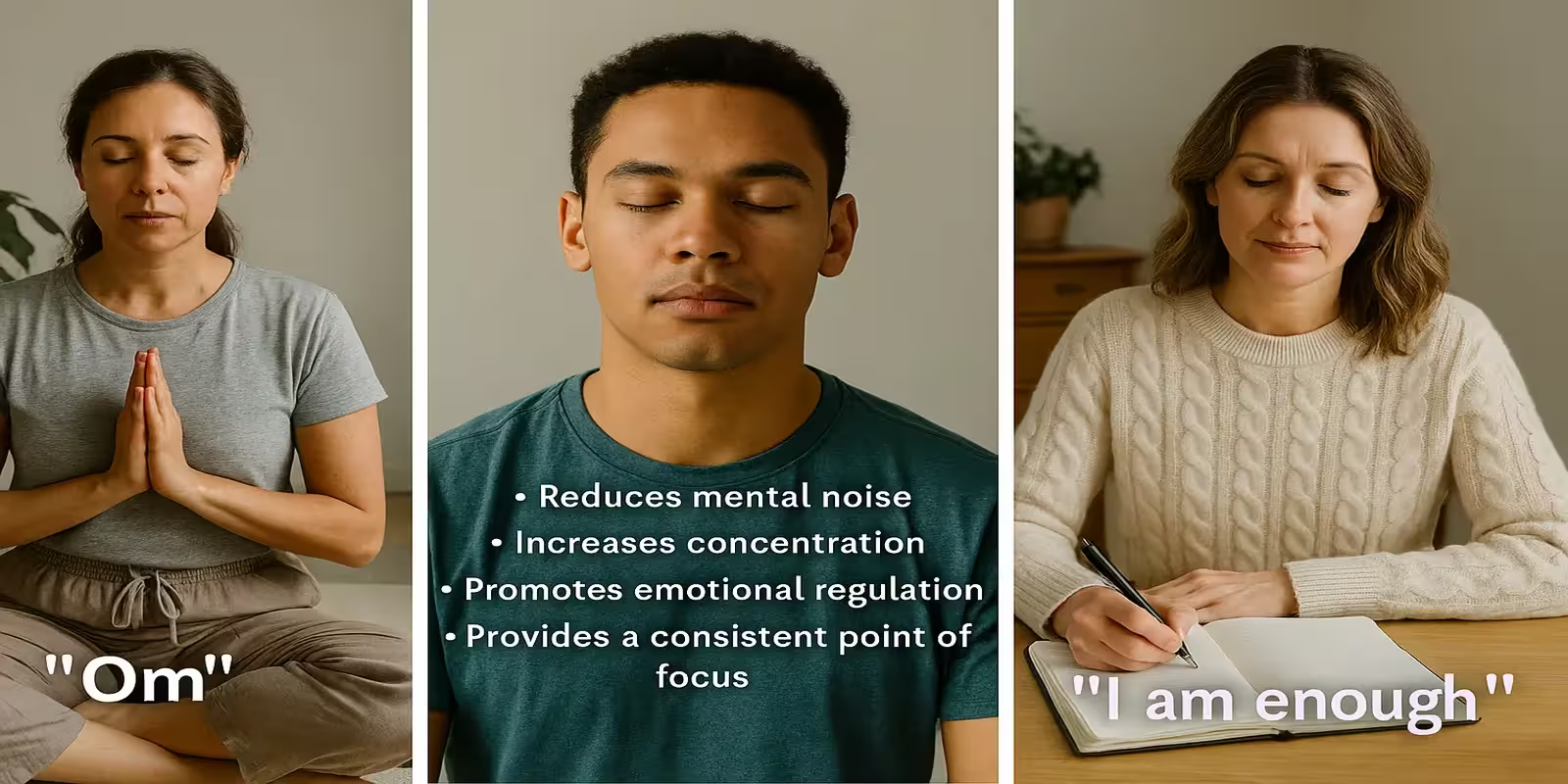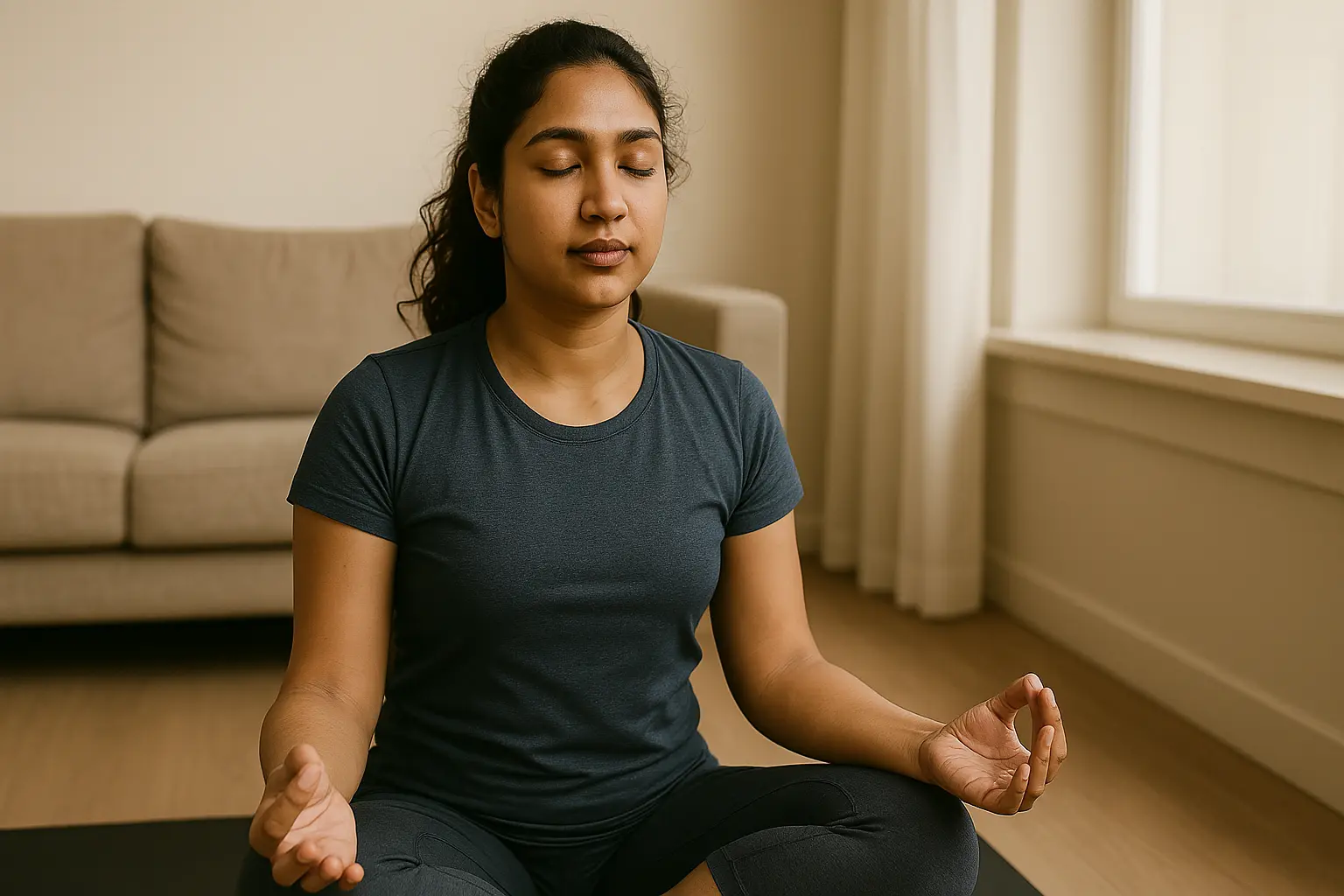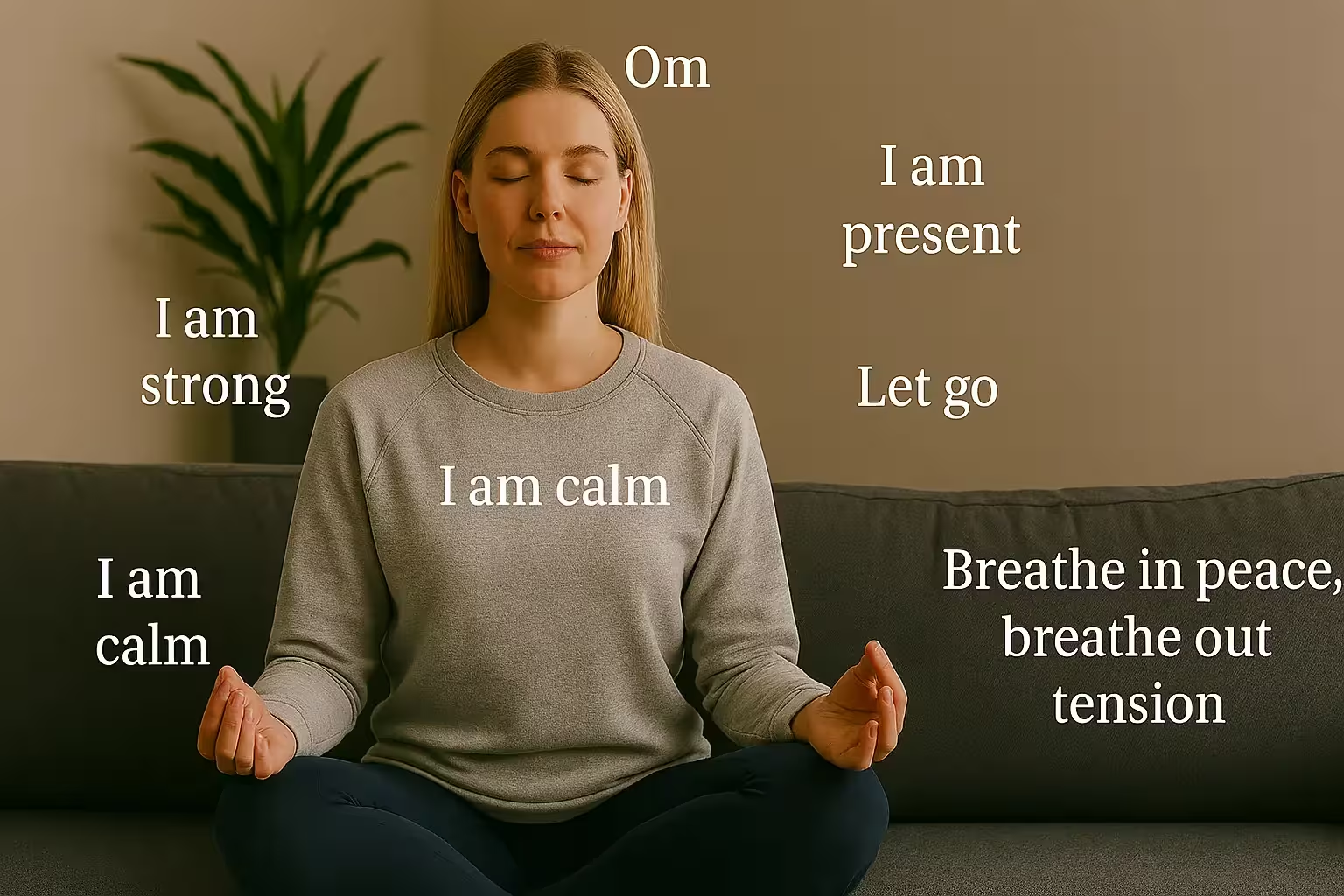How To Use Mantra Meditation For Beginners!

Meditation doesn’t always come effortlessly. Thoughts race. Distractions creep in. Settling the mind can feel out of reach.
This is where mantra meditation can help. A mantra is a word or phrase you repeat to stay centered. It gives your mind something to return to when it wanders, helping you relax and refocus.
In this article, meditation coach Vishnu Ra breaks down how to use mantras to steady your mind, especially when meditation feels difficult.

21 Mantras for Meditation
Finding the right mantra meditation can deepen your meditation experience. Below are 21 mantras, each paired with its purpose and benefit to help you choose based on your current state or intention:
- Om – The universal vibration. Calms the nervous system and centers your awareness.
- I am present – Brings your focus into the here and now.
- I am aware – Encourages mindfulness and mental clarity.
- Om Namah Shivaya – A Hindu mantra for inner peace and surrender to the higher self.
- Om Mani Padme Hum – A Buddhist mantra for compassion and heart-centered awareness.
- I am calm – Helps release tension and quiet the mind.
- Breathing in peace, breathing out tension – Supports deep breathing and relaxation.
- I am grounded – Reinforces stability during anxious or scattered moments.
- I love and forgive myself – Promotes emotional healing and self-acceptance.
- I am enough – Counters self-doubt and builds self-worth.
- I accept myself as I am – Strengthens inner peace through self-compassion.
- I refuse to give up – Builds determination and mental resilience.
- I am strong – Cultivates inner strength and confidence.
- I have what I need within me – Reinforces self-reliance and calm.
- I rise with every challenge – Shifts your mindset toward growth and grit.
- I am love – Opens your heart and shifts you into compassion.
- I am whole and complete – Encourages self-integration and peace.
- Let go – Releases resistance and emotional clinging.
- I surrender to the flow of the universe – Builds trust in life’s timing.
- My life is a miracle – Cultivates gratitude and wonder.
- I am grateful for this moment – it helps you connect to joy in the present.
You can repeat these mantras silently, aloud, or write them down. Let them support your focus, regulate your emotions, and shift your state of being, one repetition at a time.

Mantra Meditation Benefits
Using mantras in meditation offers benefits that go beyond relaxation:
Repeating a mantra engages both mind and body. It shifts attention away from worry and into the present. This can lead to more clarity, emotional stability, and peace.
Licensed psychotherapist Dr. Deborah Vinall explains that mantras help bypass mental defenses. A phrase like “I am love” can settle into the subconscious and shift your self-worth. Over time, this can change how you think and feel.
Jillian Amodio, a social worker and yoga teacher, says, “Mantras create neurological pathways that support emotional regulation. They’re not magical. They’re mental training tools.”
What Type of Meditation Uses a Mantra?
Mantra meditation is a practice that involves repeating a word or phrase to help direct and stabilize your attention. This type of meditation is used in:
You don’t need a spiritual background to use a mantra. Anyone can use this tool to support their focus and awareness.
Mantra Meditation vs Transcendental Meditation
Both mantra meditation and Transcendental Meditation (TM) use the repetition of sound or words to calm and focus the mind, but they differ in structure, purpose, and accessibility.
Mantra Meditation
Transcendental Meditation (TM)
TM is a structured, trademarked technique. Mantra meditation is more open and flexible, making it easier to integrate into personal or spiritual routines without formal instruction.
Both are valid paths, choose the one that aligns with your needs, preferences, and goals.

The Ancient Origins of Mantras
Mantras have been a part of human spiritual practice for over 3,000 years, originating in the early Vedic tradition of ancient India. The word “mantra” is derived from Sanskrit, where “man” means mind and “tra” means tool or instrument, making a mantra literally a tool for the mind.
In Hinduism, mantras are integral to prayer, meditation, and rituals. Some of the most well-known mantras include:
Buddhism also places great importance on mantra chanting. Mantras are used not only for meditation but also for generating compassion, protection, and wisdom. Common Buddhist mantras include:
The sound “Om” (also spelled “Aum”) is one of the most ancient and universally recognized mantras. In Hindu and Buddhist traditions, it symbolizes the primal vibration of the universe.
It is often used at the beginning or end of a meditation session to help practitioners tune into a higher frequency of awareness.
These ancient phrases are more than words. They are seen as vibrational formulas believed to carry spiritual energy and affect the mind and body.
Repeating a mantra can help quiet mental chatter. It brings your focus back to the present and shifts your state of mind toward greater clarity and calm.
For centuries, mantras have helped bridge the gap between thought and stillness. They continue to serve as powerful tools for connecting the thinking mind with a more profound sense of inner presence.
Understanding Mantras When Having Trouble Meditating
When meditation feels overwhelming or frustrating, a mantra can make the process more approachable. Instead of sitting in silence and trying to “clear your mind,” a mantra gives your mind something tangible to focus on, something steady and grounding.
Here’s why mantras work so well when meditation feels difficult:
Think of a mantra as a stabilizer; it helps bring you back each time you drift. Over time, this practice can retrain the mind to focus more easily and rest more deeply. For those who find stillness difficult, mantras offer a compassionate, effective way in.

Mantras vs Affirmations: Know the Difference
Mantras and affirmations might seem interchangeable, but they serve distinct purposes rooted in different practices and intentions.
Mantras
Affirmations
Intentions
Mantras work best when you want to settle the mind and create space. Affirmations are helpful when you’re building confidence or reinforcing a goal. Intentions support both practices by aligning your energy with what matters most to you.
Understanding the distinction helps you choose the correct practice for your current emotional or mental state. Whether you’re seeking stillness or strength, clarity or courage, each tool has its place in your inner work.

Adding Mantras in Your Daily Practice
Getting started with mantra meditation doesn’t require any special training. What matters most is showing up with intention and consistency. Here’s a step-by-step approach to begin:
When your mind starts to wander, notice the shift, the distraction, without judgment and gently bring your focus back to your mantra. Each return is part of the practice. Over time, this repetition builds inner stability and strengthens your ability to focus.
You’re not aiming for perfection. You’re creating a steady rhythm that supports your mind, one breath and one phrase at a time.
Subscribe to Create Higher Vibrations!
Get Inspiration and Practical advice straight to your inbox.
Tips for Effective Mantra Meditation
To get the most from your mantra practice, consider these practical tips that build consistency and deepen your focus:
There’s no single right way to practice. What matters is that the mantra resonates with you and supports your presence. Let it become a tool that grounds you, not a task to perfect.
Discover Your Inner Self. Join Our Self-Mastery Program.
Self-Mastery Coaching gives you the space, tools, and guidance to grow, reflect and discover your values and inner strength.

Common Challenges and Solutions
Even with the best intentions, practicing mantra meditation isn’t always easy. These are a few common obstacles and how to work through them:
You feel silly or self-conscious:
- This is normal when starting something unfamiliar. To ease into the practice, try repeating your mantra in a quiet, private space where you feel safe. You can whisper it or say it in your mind. Over time, this discomfort usually fades.
You can’t focus or your mind keeps wandering:
- Distraction is part of the process. Instead of fighting it, gently return to your mantra each time you drift. Repetition builds mental strength; treat it like training a muscle. The more you practice, the easier it becomes.
You’re skeptical or unsure it’s working:
- You may not notice immediate changes. But subtle shifts happen with time—more calmness, less reactivity, a bit more awareness. Stay with it. Let the benefits reveal themselves gradually.
You get bored or restless:
- It’s okay if it doesn’t feel exciting. Boredom often comes just before deeper focus. Try adjusting your mantra or session length. Even a short, focused practice can be effective.
You expect instant results:
- Mantra meditation is a long-term practice. Think of it as planting a seed—it needs space, time, and care to grow.

Integrating Mantras Beyond Meditation
Mantras aren’t limited to your seated meditation sessions. They’re practical tools you can use throughout your day to regain mental clarity, reduce stress, and realign your mindset.
When used intentionally, mantras can create moments of calm and presence, even in a busy schedule.
Here are some real-life ways to use mantras beyond formal meditation:
Think of mantras as portable support. You don’t need a meditation cushion or a quiet room. All you need is your breath, a quiet internal voice, and a clear intention.
Final Thoughts
Meditation doesn’t have to feel like a struggle. Mantras offer structure and support. If you’re having trouble meditating, a mantra can guide your focus and calm your thoughts.
Try different phrases. See what feels right. You don’t have to force stillness. Let the repetition do the work.
Your practice is your own. Stay consistent. Stay open. Let it unfold naturally.


